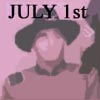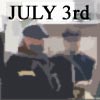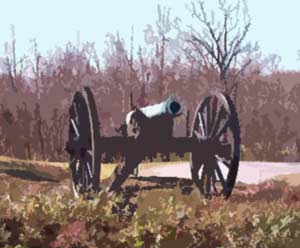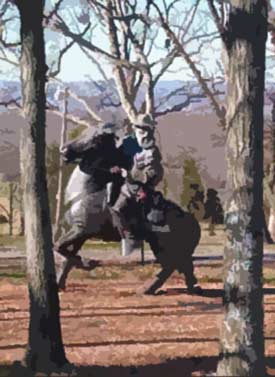






The Situation in 1863 ---
Robert E. Lee ---
Lee's Decision ---
The Campaign Begins ---
Stuart's Disappearance ---
War Comes to Gettysburg ---
General George G. Meade ---
The Final Hours Before Battle
Stuart's Disappearance --- War Comes to Gettysburg --- General George G. Meade ---
The Final Hours Before Battle
The Situation in 1863
By the summer of 1863, neither side expected a swift end to the American Civil War, as they had two years earlier, when two "amateur armies" clashed at Bull Run. Before that first battle, the Confederates boasted that one Rebel could whip 10 Yankees, while the Union insisted that one quick fight was all that was needed to clear the road to Richmond and put an end to the South’s uprising. Those sentiments were soon realized to be folly. While the losses at Bull Run were shocking, it was battles such as Antietam, Fredericksburg, Shiloh and the siege of Vicksburg that dispelled any hope that the war would end in the foreseeable future.
Entrenched near Fredericksburg, Virginia, the Confederate Army of Northern Virginia was a force of 75 000 men, rich in spirit but lacking in shoes, clothing, food and arms. Despite their shabby appearance, these men comprised one of the best fighting forces in history, and had beaten off armies nearly twice times their size, due in no small part to their unwavering faith in their commander, General Robert E. Lee. Born on January 19, 1809 in Stratford, Virginia, Robert E. Lee was perhaps the greatest soldier that the United States ever produced. The son of Revolutionary War hero "Lighthorse Harry" Lee, Robert graduated from the United States Military Academy at West Point in 1829, having studied there for four years and having not received a single demerit point. Graduating at the top of his class, Lee was posted to the Engineering Corps and found himself on General Winfield Scott's staff during the Mexican War, where he also served as a scout. In addition to his engineering postings, Lee returned to West Point in 1852 to serve as the superintendent. Transferring to the cavalry, Lee led a group of Marines against John Brown's insurrection at Harper's Ferry in 1859. With Virginia's secession in April 1861, Lee, offered command of the Union army, instead resigned his post and cast his lot with the newly-formed Confederacy. While serving in several backwater posts, Lee was, at first, unpopular among those who served under him. His defensive tactics earned him such nicknames as "Granny Lee" and "The King of Spades". By 1862, however, he had been recalled to Richmond and, with the wounding of Joseph Johnston, was put in command of the Confederate army in the Eastern Theatre, which he renamed "The Army of Northern Virginia". Lee managed to drive an invading Federal army from the gates of Richmond in his first campaign. His army would constantly be outnumbered and outgunned, but they would never be outfought. At battles such as the Second Bull Run, Fredericksburg and Chancellorsville, Lee would somehow manage to take his battered army and lead them to victory against a much bigger and more well equipped Union enemy. And his men loved him for it. By 1863, he was no longer "Granny Lee", he was "Marse Robert".

Their Union counterparts in the Army of the Potomac were better equipped and had the advantage of being supplied by the rich industrial regions of the North, which were able to keep them in a ready supply of uniforms, guns and food. However, of the six major engagements of the Civil War to date, they had not won a single battle. The best they could say was that they had been left in command of the field after only one, when North and South battled to a draw at Antietam Creek, Maryland, on September 17, 1862, the single bloodiest day of the war, when 26 000 men fell. Hardly a major victory, although it ended Lee's first invasion of the north. Meanwhile, they had been forced to march under commanding general after commanding general: McDowell, McClellan, Pope, McClellan again, Burnside and now "Fighting Joe" Hooker. None of these commanders seemed to be able (or, in some cases, willing) to do what was necessary to defeat Lee and the Confederate army. Still, the Army of the Potomac had some 100 000 men in uniform, despite losses of nearly 12% at the battle of Chancellorsville in May, and the departure of another 20 percent with the end of their 2-year enlistment terms, signed in 1861.
If things were going badly for the Union in the East, they were going better in the West. Along the Mississippi, the Union (whether it knew it or not) had the general that would eventually defeat Lee. Hiram Ulysses Grant (but known as Ulysses S. Grant after a mix-up at West Point years earlier) was helping to implement the same "Anaconda Plan" that General Winfield Scott had been laughed at in 1861 for formulating. While Scott's plan for a blockade of Union ports was already in effect, Grant was helping to further "squeeze" the life out of the Confederacy, in an effort to bring control of the Mississippi River into Union hands and effectively cut the Confederacy in two. The Union General-in-Chief Henry Halleck (nicknamed "Old Brains") was heard to say "In my opinion, the opening of the Mississippi River will be to us more advantage than the capture of forty Richmonds."
By the time the Gettysburg Campaign got underway, Grant had made his way to Vicksburg, a virtually impregnable fortress occupying a high bluff overlooking the Mississippi and defended by heavy artillery that made direct naval assault impossible. Frontal attacks by land proved disastrous as two such assaults in late May were repulsed with heavy casualties. Instead, Grant decided to lay siege to the city, in hopes of pounding and starving Vicksburg into capitulation.
But Vicksburg and the area along the Mississippi was not the only Confederate territory that was endangered. For the majority of the time since the outbreak of the war, Virginia had been the principal battleground for the war in the East. Troops on both sides and used her fields and farms as forage-grounds. It was beginning to take its toll on both the morale and the economy of the South's civilians.
Lee's Decision
On May 15th, 1863 Lee met with Confederate President Jefferson Davis and Secretary of War James Seddon in the capital of Richmond, Virginia. Concerned with the situation in Vicksburg, Seddon called for two of Lee’s divisions to be sent as reinforcements to the besieged city. Braxton Bragg's army in Tennessee, which had tried to reinforce Vicksburg's defenders under John C. Pemberton, was blocked by the Union troops of William Rosecrans.
Believing that two divisions was insufficient to break the siege at Vicksburg and would only weaken his own forces, Lee called for a second invasion of the north, to strike into the heart of Pennsylvania, as he had been unable to do a year earlier when his troops were turned back at Antietam.
Although he knew that an attack on the Federal capital of Washington was out of the question, Lee argued that an invasion on Northern soil would draw the war out of Virginia, giving the farmers of the Shenandoah Valley sufficient time to harvest their crops. A Confederate movement north would also disrupt Union operations along the coasts of Virginia and North Carolina. Perhaps, such an invasion might even force a nervous Washington to draw troops away from Vicksburg in the West and might do what Lee's 1862 campaign could not: bring about foreign recognition of the Confederacy and force the Union to sue for peace.
Not everyone was convinced of Lee's plan. Both General James Longstreet and Confederate Postmaster General John H. Reagan believed that such an operation was foolhardy. Reagan went so far as to convince Davis that a second vote of the Confederate cabinet on the issue was needed. On May 17th, the Cabinet again voted 5-1 in favor of Lee's invasion of the North.
With the approval to go north his, Lee had to prepare his army for this most important mission. Over the next three weeks, he brought up as many guns and reinforcements as was possible. As well, he reorganized his army from two Corps into three, with each Corps consisting of three divisions. Longstreet, who Lee referred to as his "Old Warhorse" would retain command on First Corps, but Lee's former Corps Commander, General "Stonewall" Jackson had been killed at the battle of Chancellorsville. In his place, Lee promoted Richard S. Ewell to command the Second Corps, while Ambrose P. Hill was named to command the Third Corps. Both Ewell and Hill were capable men but, to Lee's undoing, neither one could replace Jackson.
 On June 3rd, 1863, the Gettysburg Campaign officially began as elements of McLaws’ and Hood's divisions of Longstreet's 1st Corps left their encampments near Fredericksburg and began to move towards Culpeper Court House, where J.E.B. Stuart's Cavalry Corps was located, with the rest of Longstreet's Corps following soon after. A.P. Hill's Corps remained at Fredericksburg.
On June 3rd, 1863, the Gettysburg Campaign officially began as elements of McLaws’ and Hood's divisions of Longstreet's 1st Corps left their encampments near Fredericksburg and began to move towards Culpeper Court House, where J.E.B. Stuart's Cavalry Corps was located, with the rest of Longstreet's Corps following soon after. A.P. Hill's Corps remained at Fredericksburg.
Hooker, alerted to Lee's movements, believed that the Confederates were attempting to cut him off from Washington. Hooker sent his own Cavalry Corps, commanded by General Alfred Pleasonton, to "disperse and destroy the rebel force assembled in the vicinity of Culpeper, and to destroy his trains and supplies." The result was the Battle of Brandy Station which did nothing to deter Lee's march north. Hooker believed that, with the way to Richmond open, he should march on the Confederate capital, but Lincoln objected, stating "I think Lee's army, and not Richmond, is your sure objective point." Many within the Federal cabinet had little faith in Hooker's abilities after the defeat at Chancellorsville.
Ewell's Corps, consisting of 23 000 troops, would lead the Confederate march north, towards a destination not even Lee knew as yet, clearing Winchester, Virginia of the Federal garrison stationed there on June 13th and crossing the Potomac near Sheperdstown and Williamsport two days later (led by cavalry under Jenkins and elements of Rodes' division). Meanwhile, Longstreet's and Hill's Corps left their positions at Culpeper and Fredericksburg, respectively, on June 14th, to join Ewell.
Hooker consolidated his troops near Centerville and Fairfax Court House, Virginia in order to protect Washington but, in doing so, broke contact with the enemy and assigned Pleasonton to the task of keeping tabs on Confederate movements. For the next 10 days, Hooker and the Army of the Potomac remained stationary, as Lee's army moved north. The Confederate Army of Northern Virginia and Union elements would meet in small, meaningless skirmishes in places like Aldie, Virginia and Middletown, Maryland and McConnellsburg, Pennsylvania. Unfortunately for Hooker, his most important battle would be with Washington.
On June 24th, Longstreet and Hill began to cross the Potomac, joining Ewell in the invasion of Maryland and Pennsylvania. As the remnants of the Army of Northern Virginia moved north, Lee still had no clear idea of his final destination, nor where he would engage the Union army. He ordered Ewell to advance on a broad front allowing "nature to take its course".
By this time, Rodes’ division (Ewell's Corps) was in Chambersburg, Pennsylvania. His division, along with that of Edward Johnson's, moved northeast to Carlisle. Early's division was moving east towards York, Pennsylvania, and, on June 26th, moved through the small town of Gettysburg. En route to York, Pennsylvania, part of Early's division passed through the small town on June 26, 1863. Pausing briefly, Early order the town to turn over to him 60 barrels of flour, 7,000 pounds of pork, 1,200 pounds of sugar, 600 pounds of coffee, 1,000 pounds of salt, 10 bushels of onions, 1,000 pairs of shoes, and 500 hats or pay $10,000. The president of the borough council, Dr. David Kendlehart, told Early that his demands were impossible to meet. Under orders to advance on York, Early did not press the issue. In York, he demanded and received $28,000 from the local government there.
 In June, 1863, the hamlet of Gettysburg, Pennsylvania had a population of 2400 people. Founded in 1780 by James Getty, Gettysburg had become the seat of Adams County and was noted for leather and carriage manufacturing, as well as the Lutheran Theological Seminary and Pennsylvania (now Gettysburg) College. No fewer than 10 roads met in Gettysburg. In July 1863, those roads would bring war to the small town.
In June, 1863, the hamlet of Gettysburg, Pennsylvania had a population of 2400 people. Founded in 1780 by James Getty, Gettysburg had become the seat of Adams County and was noted for leather and carriage manufacturing, as well as the Lutheran Theological Seminary and Pennsylvania (now Gettysburg) College. No fewer than 10 roads met in Gettysburg. In July 1863, those roads would bring war to the small town.
By the 27th, Early was in York, only to find that the bridges across the Susquehanna River had been destroyed along with the Confederates' chances of driving on to Harrisburg, Pennsylvania's capital. Early remained in York, awaiting Ewell's orders. By the next day, Longstreet and Hill were in Chambersburg, and divisions of Hill's Corps crossed the mountains to York and Carlisle, the furthest north that Lee's army would penetrate.
Hooker Resigns
Throughout the early part of the Gettysburg Campaign, Hooker had clashed with both Lincoln and Henry Halleck over the way the war should be run. Hooker wanted more men to better fight Lee's invading army, even if it meant stripping Washington's defenses and abandoning the strategic stronghold of Harper's Ferry. Halleck refused, rapidly losing confidence in the commander of the Army of the Potomac. Halleck did eventually send Hooker another 15 000 men, enough to spur “Fighting Joe” into action, as the Army of the Potomac finally began to move against Lee's invasion of the north.
That still wasn't enough for Hooker, who believed that he would be unable to confront Lee properly without the use of the troops defending Harper's Ferry. Finally on June 27th, Hooker had reached his breaking point. Stating that "I am unable to comply with conditions with the means at my disposal.", Hooker resigned his command and Lincoln accepted it. Halleck named General George Meade to replace Hooker.
Who was George G. Meade?
Born on December 31, 1815 in Cadiz, Spain, George Gordon Meade was the son of an American naval agent. By 1863, Meade made his residence in Pennsylvania making him an ironic choice to lead the Northern Army in defense of his home state. A graduate of West Point in 1835, Meade had left the army after his required service was finished to become a civil engineer. In 1841, he returned to the army to serve in the Engineering Corps and later saw action in Mexico.
A captain when the war broke out, Meade was soon promoted to brigadier general of volunteers and given command of a brigade of Pennsylvanians. Meade led his men into battle during the Peninsula Campaign, where he was wounded at the battle of Glendale. Returning to the army, he served as a brigade commander at 2nd Bull Run, commanded a division at South Mountain and Antietam, and a corps at Fredericksburg and Chancellorsville.
Meade was described as a "thorough soldier" and "a mighty clear-headed man". Meade was neither dashing nor popular, but his men trusted his judgment. Lee, in hearing of Meade's appointment, knew that he could make no mistakes against this man.
Information from several sources led Meade to believe that the bulk of Lee's army was near Chambursburg and the new commander soon had his infantry on the march towards Pennsylvania, amid hot weather and rain that kept the dust of the march to a minimum. He ordered Dan Sickle's III Corps to join John Reynolds’ I Corps and Howard's XI Corps outside Emmitsburg, just south of the Maryland/Pennsylvania border. Meade's plan of action called for the Union to defend against any Confederate attack, before withdrawing to form defensive lines along Pipe Creek in Maryland, some fifteen to twenty miles away. In Meade’s mind, Pipe Creek was a perfect spot to cover his base of supplies at Westminster, MD and block any movement that Lee might make towards Washington.
Stuart's Disappearance

The Battle of Brandy Station had humiliated Stuart and his Confederate cavalry troops, and he was itching for revenge.
On June 9th, Stuart's Union counterpart, Alfred Pleasonton had ordered John Buford to undertake a frontal assault on Confederate positions while units under Gregg and Duffie would attack their right flank and rear. Despite Duffie's troops getting lost in the planning stages of the attack, Stuart was still taken by surprise. Buford's men overran sections of the Confederate line before the Rebel horsemen repelled the attack. Stuart dismissed reports of Union movement to the southeast, refusing to take it seriously at first. Finally, he sent four cannon and two cavalry regiments under William Jones to reinforce that area.
Jones' men charged right into an advance by Perry Wyndham, and bitter fighting ensued. Wyndham managed to carry Fleetwood Hill, only to be driven off. After several hours of attacks and counterattacks by both sides, Pleasonton decided to pull out, and the Union cavalry made an orderly withdrawal from the field.
The casualties were less than 1400 men, with the Union taking the brunt of that number. The battle was the largest cavalry battle ever fought on American soil and while it was a victory for the Southern horsemen, the Union cavalry had proven themselves worthy opponents. No longer could Stuart's flamboyant Confederate cavalry brag about their total domination over their Union counterparts.
For most of the Gettysburg campaign, J.E.B. Stuart had filled the role he always had, screening Lee's movements and gathering information for his commander. However, on the evening of June 22nd, Lee issued orders to Stuart that told him to link with Ewell's II Corps and to keep Lee informed of the enemy's whereabouts and collect any and all supplies he could. Unfortunately, Lee included a paragraph in his orders that stated "you will, however, be able to judge whether you can pass around their army without hindrance, doing them all the damage you can, and cross the river east of the mountains. In either case, after crossing the river, you must move on and feel the right of Ewell's troops, collecting information, provisions, etc." Stuart, chopping at the bit to recreate his great ride around McClellan the year before in order to regain his pride, interpreted Lee's orders that he was to do whatever he wished in order to disrupt Federal communications and supply.
On June 24th, three Confederate cavalry brigades (those under the command of General Fitz Lee, Colonel John Chambliss and General Wade Hampton) gathered at Salem in preparation for Stuart's latest "adventure". Stuart left two more brigades (Brigadier General Beverly Robertson's North Carolina brigade and William "Grumble Jones' Virginians) to cover the rear and provide support for the rest of the army.
Before daylight broke the next day, Stuart's troops headed east. Before long, however, they had run into the middle of Hancock's II Corps, which told Stuart that the Federal army was on the move. He sent word of this to Lee, but the courier never arrived, and Lee was still as in the dark as to the exact location of the Army of the Potomac as Hooker was of the Army of Northern Virginia.
Stuart was now forced to travel further south than expected in order to get around the main body of the Federal army. This extended march, as well as delays to tend to the horses, meant that it wasn't until June 27th that Stuart crossed the Potomac, at Great Falls, 12 miles above Washington D.C. Even then, finding a place to cross took some doing, especially when it came to the artillery and ambulances. To the cavalry's credit, not a single man or piece of equipment was lost as the Confederate cavalry crossed the Potomac.
At dawn on June 28th, Stuart was in Maryland but two mountain ranges and an enemy army separated him from Lee. By noon, the Confederate cavalry was in Rockville, in the District of Columbia. After being the toast of the mostly pro-Southern citizens, they captured most of a Federal supply train of 150 wagons and gave pursuit to the rest, a pursuit that brought many Confederate cavalrymen within sight of the Union capital of Washington. Stuart considered attacking Washington, only to abandon the idea with the coming of nightfall.
 Stuart's actions included cutting telegraph lines between Washington and Baltimore, burning bridges and destroying large sections of Federal railway lines, not to mention brief skirmishes with Union cavalry units in the area. Unfortunately, by June 29th, with the Confederate cavalry at Westminster, Stuart had no idea where Lee and the rest of the army was. Reading in local papers that Early was at Wrightsville, some 30 miles to the northeast, Stuart set out to link up with the Army of Northern Virginia.
Stuart's actions included cutting telegraph lines between Washington and Baltimore, burning bridges and destroying large sections of Federal railway lines, not to mention brief skirmishes with Union cavalry units in the area. Unfortunately, by June 29th, with the Confederate cavalry at Westminster, Stuart had no idea where Lee and the rest of the army was. Reading in local papers that Early was at Wrightsville, some 30 miles to the northeast, Stuart set out to link up with the Army of Northern Virginia.
After an exhausting ride, Stuart's cavalry reached Hanover, expecting to link up with Early. Instead, they found Kilpatrick's Federal cavalry. Stuart's troopers drove one of Kilpatrick's rear guard units back through the streets of Hanover and briefly gained control of the town. Later, however, a Federal counterattack drove the Rebel cavalrymen back.
Weighed down by Union prisoners and the captured Union train (the placement of which had prevented Stuart from reinforcing Chambliss's brigade), Stuart did not want to become involved in a major engagement. That evening, Stuart moved east through Jefferson towards York. Discovering that Early was not in York,(he and Early had missed each other by a matter of a few miles) Stuart headed toward Carlisle. Over a 36-hour period on June 30-July 1st, Stuart and his cavalrymen would ride more than 70 miles and endure a tough fight at Hanover.
The Final Hours Before Battle
With Stuart absent, Lee was very much in the dark as to the Federal position. He had assumed that Hooker and the rest of the Federal army was still in Virginia. On the evening of June 28th, Lee issued orders for the next phase of his operation into Pennsylvania. Ewell was to take Harrisburg, with Longstreet in support. Hill was to follow Early's lead and cut the Pennsylvania railroad between Harrisburg and Philadelphia. By 10:00, that evening, Lee's plans had been dashed with the information gained from Henry Harrison, a spy employed by Longstreet. Harrison told Lee about Meade's rise to command of the Army of the Potomac and that the Federal army was at Frederick, MD, with one corps near South Mountain.
Horrified to learn that not only was the enemy closer than he expected, but that Meade could be on the verge of cutting off his line of communications and supply, Lee canceled his previous orders and called for his forces to converge east of the mountains near Cashtown. There they would form battle lines and either engage Meade or feint towards Washington.
Meade's own information about the Confederates was sketchy at best. He knew Ewell was at Carlisle and Early was at York, with the bulk of Lee's army supposed to be near Chambersburg. The Federal army moved swiftly, and by the evening of June 29th, were less than 10 miles from Gettysburg, with their left flank at Emmitsburg, MD.
On June 30th, Rodes' and Early's division reached the area around Heidlersburg, just 9 miles north of Gettysburg. Divisions of Hill’s Corps (under Harry Heth and Dorsey Pender) were closer, just eight miles from Gettysburg to the east of South Mountain. Most of Longstreet's Corps was still west of that position.
Meanwhile, Stuart's cavalry had entered Pennsylvania, and collided with Kilpatrick's division at Hanover. The Union horsemen drove their Confederate counterparts back to the town of Jefferson, where Stuart waited until the evening of July 1st.
When Early's troops had occupied the town of Gettysburg a few days before, they noticed a shoe factory in Gettysburg. On June 30th, James J. Pettigrew's brigade (under Heth) entered the village to acquire some much-needed shoes. Their stay in Gettysburg was a short one, withdrawing as cavalrymen under John Buford rode into town. Buford put two brigades along the Chambersburg Pike to ward off any other Confederate advances.
Harry Heth and Ambrose P. Hill dismissed Pettigrew's claim that Union cavalry now occupied the town of Gettysburg. Heth still planned to send a force into the town on the morning of July 1st, so as to get those shoes.